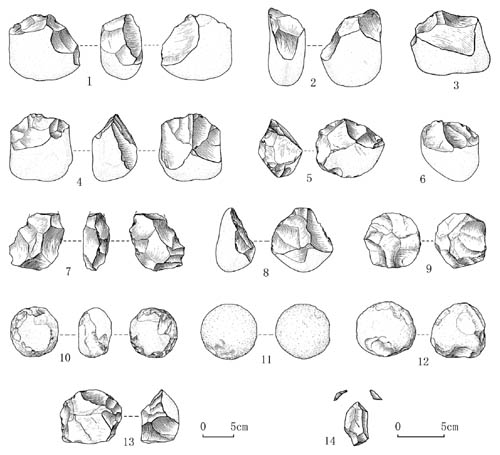| Location: Home > Research > Research Progress |
| New Paleolithic Sites Discovered in Hanzhong Basin, Central China |
|
The catchment of Hanjiang River is regarded as one of the most important Paleolithic sites in central China. During 2009-2012, a scientific team led by Dr. WANG Shejiang, Institute of Vertebrate Paleontology and Paleoanthropology (IVPP) of the Chinese Academy of Sciences, conducted surveys and discovered two new Paleolithic open-air sites in the Hanzhong Basin. Researchers unearthed 252 stone artifacts, and reported the finding in the journal of Acta Anthropologica Sinica 2014 (2). This study indicates hominins already occupied the Hanzhong Basin from approximately 600000 years ago, and provides important data for the study of human adaptive strategies and patterns in this region and as well as the Palaeolithic culture and human behavior in East Asia. Two new Paleolithic open-air sites, Hejialiang and Yaochangwan, are located in the upper valley of Hanjiang River in the southern piedmont of the Qinling Mountains, central China. The lithic assemblage analysis suggests that the stone artifacts were made of local raw materials of pebbles/cobbles which derived from the riverbank alluvial deposits of the Hanjiang River. The lithic samples from the Hejialiang site frequently made of quartz, Graywacke, and igneous rock, but infrequently made of quartzite and silicon limestone. The lithics of the Yaochangwan site more frequently made of quartz, quartzite and igneous rock, but infrequently made of sandstone and silicon limestone. The main techniques used are direct hard hammer percussion and bi-polar techniques. The core and flake platforms are dominated by cortical surfaces. The lithic artifacts consist of hammer stones, cores, flakes, retouched tools and flaking debris. The retouched tools include choppers, spheroids, hand-axes, picks, heavy-duty scrapers, small scrapers and point. Composition and technology of the lithic artifacts in the two sites share some common characteristics with Paleolithic open-air sites in the Ankang Basin, the Danjiang Reservoir areas in the lower valley of the Hanjiang River, and the Luonan Basin in the South Luo River, and the Bose Basin in south China. The Hejialiang site is on the second terrace. There is a thin eolian deposit with thickness of 5.2 m covering on the fluvial sand, pebbles, and cobbles, and an in situ flake was just found at the lower part of the unique paleosol layer in the Hejialiang section. In the Yaochangwan site, distinct loess and paleosol alternations are present on the third river terrace with a thickness of more than 15 m. From this loess-paleosol sequence, five loess units and five paleosol complexes can be identified. Two in situ flakes were found in the fifth paleosol layer at a depth of 14 m. Researchers collected two samples at Hejialiang section and five samples at the Yaochangwan section for TT-OSL (Thermally transferred optically stimulated luminescence) dating. The TT-OSL is a newly developed dating technique which probably extends the dating range of quartz samples to middle and early Pleistocene. The dating results suggest that the buried lithic artifacts layer at the Hejialiang site is approximately correlated with the last interglacial paleosol S1 in Chinese Loess Plateau, dated from 80000 to 70000 years ago. The Yaochangwan site spans approximately from 600000 to 100000 years ago and correlates with S5-S1 in the typical Chinese loess paleosol sequences. These ages suggest that hominins already occupied the Hanzhong Basin approximately 600000 years ago. This work was supported by the One Hundred Talent Person Project of the Chinese Academy of Sciences, the Strategic Priority Research Program of the Chinese Academy of Sciences and the National Natural Science Foundation of China.  Fig.1 Lithic artifacts from the Hanzhong Basin. 1, 3-4, 6, choppers; 2, 8, picks; 5, 13, scrapers; 7. hand-axe; 9, 11-12, spheroids; 10, hammer stone; 14, point. (Image By WANG Shejiang) |